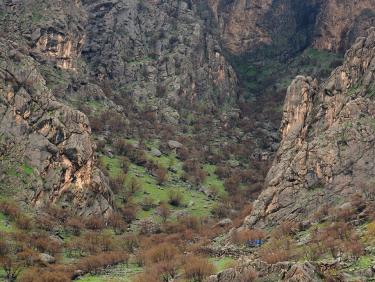ProjectThe Mountain Fortresses of Rabana-Merquly in Iraqi Kurdistan
The archaeological site of Rabana-Merquly is located on the flanks of Mt. Piramagrun in the Zagros Mountains of Iraqi Kurdistan. This fortified stronghold consists of perimeter defenses encircling adjoining settlements in the Rabana valley and on the Merquly plateau. The main Parthian-era occupation dates from the second to first centuries BCE. Parts of the complex were also reoccupied during Ottoman and modern times.

Perimeter defences and intramural settlements
Perimeter fortifications at Rabana-Merquly can be viewed as an extension of the surrounding highland landscape. Walls were constructed to block intruders where gaps in the western escarpment of Mt. Piramagrun at the valley base and along its upper ridges would otherwise allow access. The result was a near continuous barrier c. 4000 m in length, with the difference in height between the lowest and highest fortifications being c. 720 m (1180–1900 meters above sea level).
Inside Rabana the focus of occupation was in the north-east, where the wadi running through the center of the valley enters from a narrow gorge extending high up into the mountain. After heavy rain and snowmelt this forms an ephemeral waterfall, the base of which is canalised with monumental stone architecture. Close by, a small (fire?) altar within a sub-rectangular niche is carved into the escarpment. The overall impression is of a sanctuary complex, with the prominence of water suggesting a cultic link to the goddess Anahita.
Current research complements the results of previous excavations at Merquly in 2009 by the Slemani Antiquities Directorate that explored a citadel built on high ground (Saber et al. 2014). This overlooks several buildings, including seven of standardized rectangular design, each with five rooms of approximately equal size. Based upon parallels with Roman/Sasanian forts these structures most likely functioned as barracks. The defensive function of the fortress probably extended to a garrison at Merquly, well placed to counter threats emanating from the surrounding highlands.

Rock-reliefs and the kingdom of Adiabene
A defining feature of Rabana-Merquly are matching rock-reliefs that depict an anonymous ruler, carved into the cliff adjacent to the entrances of both settlements. Similarities in attire between these figures and the statue of a king of Adiabene found at Hatra suggest a possible identification for both this individual (Natounissar) and the ancient city (Natounissarokerta on the Kapros). While its precise affiliation is a matter of speculation, Rabana-Merquly would have fallen under the dominion of the Parthian Empire, located close to the south-east frontier of the vassal kingdom of Adiabene.
As a major center positioned at the intersection between highland and lowland zones, Rabana-Merquly would have played a role in regulating interactions with mountain pastoralist groups, through military coercion and as a trading hub. Rabana-Merquly also overlooks the most direct route from Erbil south towards the Sharizor Plain, and it is conceivable that the ‘sanctuary’ could have been a pilgrimage destination in its own right, positioned along a major thoroughfare crossing the Zagros Mountains.

Bibliography
Brown, M., and R. Rashid. 2024. “A Possible Parthian-Era Anahita Sanctuary at Rabana in the Kurdistan Region of Iraq”, Iraq 85. doi:10.1017/irq.2023.6
Brown, M., and R. Dörr. 2023. “Die Bergbefestigungen von Rabana-Merquly”, in J. Marzahn and D. Wicke, eds. Zwischen Schwarzem Meer und Persischem Golf. 125 Jahre Deutsche Orient-Gesellschaft. Darmstadt: Wissenschaftliche Buchgesellschaft, pp. 146–151.
Brown, M., K. Raheem and H. Abdullah. 2022. “Rabana-Merquly: A fortress in the kingdom of Adiabene in the Zagros Mountains”, Antiquity 96 (388): 920–936.
Brown, M. 2020. “The Mountain Fortresses of Rabana-Merquly in Iraqi-Kurdistan”. BAF-Online: Proceedings of the Berner Altorientalisches Forum 4 (1). https://doi.org/10.22012/baf.2019.19.
Brown, M., K. Rasheed, R. Dörr and J. Heiler. 2020. “Die Bergbefestigung von Rabana-Merquly in Irakisch-Kurdistan: Ein Vorbericht der Grabungskampagne 2019”, Mitteilungen der Deutschen Orient-Gesellschaft 152: 91–110.
Brown, M., P. Miglus, K. Rasheed and M. Ahmad. 2018. “Portraits of a Parthian king: rock-reliefs and the mountain fortresses of Rabana-Merquly in Iraqi Kurdistan”, Iraq 80: 63–77.
Saber S.A., Z. Rejeb and M. Altaweel. 2014. “Report on the Excavations at Merquly: the 2009 Season”, Iraq 76: 231–244.
Project Partners
Particular thanks are due to Heidelberg University student volunteers, the community of Qarachatan and Najmaden Ahmad who is the site custodian of Rabana, together with our colleagues from Sulaymaniyah; Rebin Rashid, Saber Ahmed Saber (Slemani Antiquities Directorate) and Sakar Majid (Slemani Museum ). We also express our appreciation to Hussein Hama Gharib (Director of Antiquities in Slemani), Kamal Rasheed Raheem (former Director of Antiquities in Slemani) and Kaifi Mustafa Ali (General Director of Antiquities in Iraqi Kurdistan).
Continuing investigations at Rabana-Merquly are funded by the Deutsche Forschungsgemeinschaft as part of the project, ‘Parthian Imperial Control and Local Agency in the Central Zagros Highlands’ (DFG project number 423891597 ). Fieldwork in spring 2019 was funded by grants from the Deutsche Orient-Gesellschaft and the British Institute for the Study of Iraq. Research in 2017-18 was supported by a Transcultural Forays Fellowship awarded to Dr. Michael Brown by the Heidelberg Centre for Transcultural Studies. Studies of the Rabana-Merquly rock-reliefs in 2016 were undertaken as part of a wider project supported by the Gerda Henkel Stiftung.
